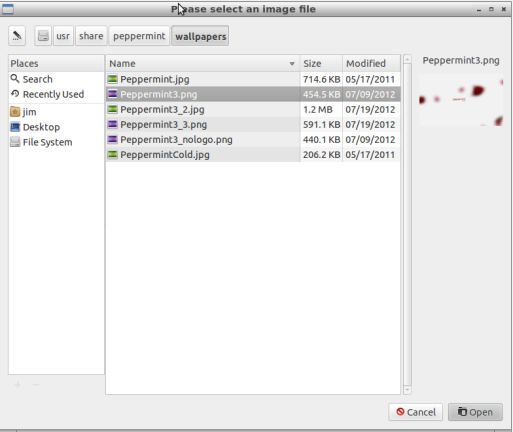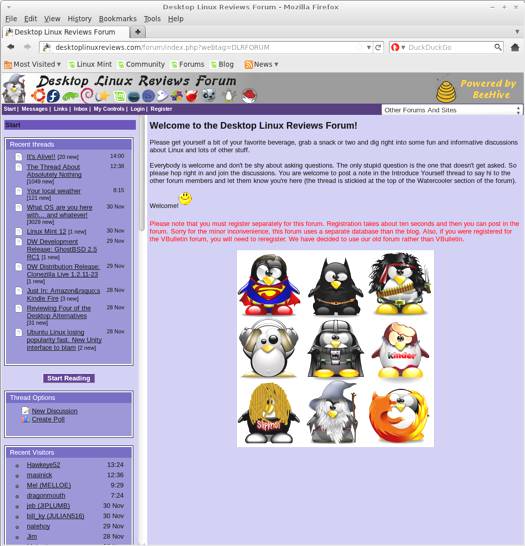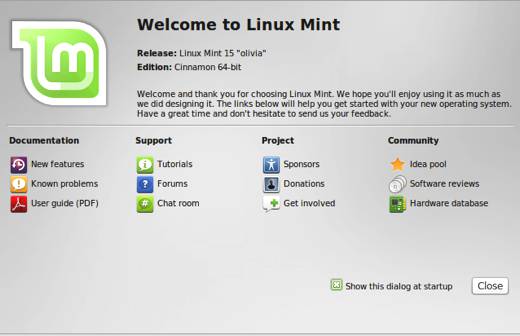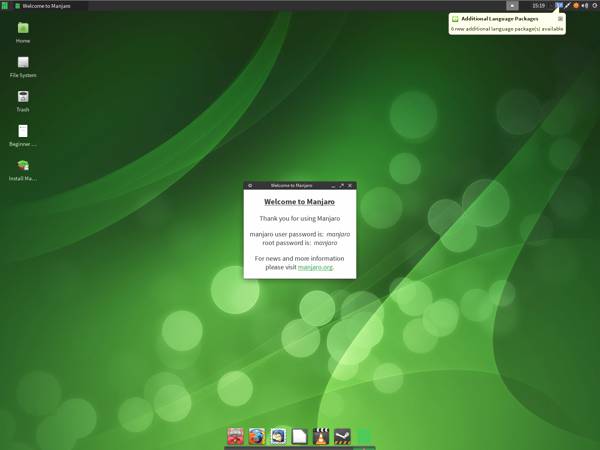Peppermint OS 3 has been released. If you aren’t familiar with it, Peppermint OS is a cloud-oriented distribution. It’s based on Ubuntu 12.04 (it’s actually a fork of Lubuntu 12.04).
Unlike most other distributions, it’s geared toward letting you use your favorite web apps as well as desktop software. Web apps such as Editor by Pixlr run in the Ice SSB framework, which makes these applications a part of your desktop rather than running them in a browser. This makes them feel like they are running locally rather than in the cloud.
SSB, by the way, is an acronym for “site specific browser.” Here’s more on SSB’s from the Peppermint OS site:
Ice is, by definition, a Site Specific Browser [SSB] that Peppermint creator Kendall Weaver wrote himself as a means to launch Web Applications and/or Cloud Applications [SaaS - Software As A Service] from the new Peppermint Ice OS. When you launch a web based application using Ice it will call up a custom SSB using the default Chromium Browser. So, essentially, the Ice SSB acts as software that is installed locally but is actually delivered via the Web.
The difference in using an SSB as opposed to using a tabbed browser is that only one function is assigned to the Ice SSB. In a tabbed browsing system, with several open for example, if one service or site in any given tab crashes you run the risk of losing data by crashing the other tabs and potentially the browser itself. since an SSB is isolated and dedicated to only operating the web application of your choice, if it crashes or hangs, it does not effect the rest of the system. And, because the Ice SSB’s are so sleek, they are perfect for running apps that display better using the most screen area as possible.
Using Ice you can add or remove web applications, including the ones that come with Peppermint OS 3 by default. Ice gives you a lot of power to control the web applications that you’ll be using in Peppermint OS 3.
To add or remove web applications, follow these instructions:
How to Add an App in Ice SSB
1. Click the Menu button on the panel.
2. Click the Internet category.
3. Click the Ice icon in the drop down menu.
4. Type in the URL and name of the web app you want to add.
5. Choose where you want it to appear in the menus.
6. Choose an icon for the web application.
7. Click the Create button.
How to Remove an App in Ice SSB
1. Click the Menu button on the panel.
2. Click the Internet category.
3. Click the Ice icon in the drop down menu.
4. Click the Remove tab on the Ice menu.
5. Select the app you want to remove.
6. Click the Remove button.
What’s New In This Release
Here’s a sample of the new features in this release:
Chromium stable repository enabled by default
Light theme and default art
Fewer web applications installed by default
GWOffice included
GIMP 2.8 is in the Peppermint repository
Peppermint OS uses Linux Mint’s update manager again
Chromium is the default browser in Peppermint OS 3, and it’s an excellent choice. Since the stable repository is enabled already, you will get updates right when they become available.
The new, lighter them is attractive and clean. It works well within Peppermint OS, though the default wallpaper left something to be desired (more in the problems section on that).
The developers have opted to include less web applications by default. I have mixed feelings about this since some users may simply be unaware of all the great web apps available to use on Peppermint OS 3. However, I can also understand the developers not wanting to overload people with web apps. It would be nice if there was some one-click way to add a whole bunch of them at the same time.
GWoffice is now included by default. To use it just start it and login with your Google account information. GWoffice is a desktop Google Docs client. It’s still in beta though, so be aware you may see some burps while using it.
System Requirements
Here’s what you’ll need to run this distro:
The absolute minimum required specs are as follows:
- 192 MB of RAM
- Processor based on Intel x86 architecture
- At least 2 GB of available disk space
Again, do note that these are the absolute minimum required specs. We strongly recommend having something a little stronger to install on. Our minimum recommended specs are as follows:
- 512 MB of RAM
- Processor based on Intel x86 architecture
- At least 4 GB of available disk space
Taking it a step further, the preferred minimum specs on a candidate for installation are as follows:
- 1 GB of RAM
- x86_64 or amd64 compatible processor
- At least 4 GB of disk space
Download
You can download Peppermint OS 3 from this page. The file I downloaded weighed in at 558.4 MB.
If you’re a distrohopper then you might want to try it in VirtualBox before running it on real hardware. VirtualBox is free and open source software that will let you run distros on your Linux, OS X or Windows desktop.
You can get Peppermint OS 3 in 32 bit or 64 bit versions.
Installation
Since it’s based on Ubuntu 12.04, the install is extremely easy. It took about 7 minutes or so for my install to finish.
The Desktop
The desktop is clear of icon clutter. The menu button on the panel has a cute peppermint icon in it. On the right of the panel you’ll see your network connection info, an icon to click to update your system, a notifications icon, a volume icon, the time, and the logout icon.
Applications are broken up into the usual categories:
So it’s very easy to find what you’re looking for, and it’s easy to access System Tools and Preferences via the Menu button as well.
Wallpaper
I have some…er…feedback on the default wallpaper I encountered in the problems section. To change the wallpaper just right-click your desktop and pull up the Desktop Preferences menu. Then click the wallpaper drop down menu. I like the first choice (peppermint.jpg) in the list of included wallpapers.
Bundled Software
Here’s a sample of the software included in this release.
Games
Available in Software Manager
Graphics
Document Viewer
Editor by pixlr
Express by pixlr
Pixlr-o-matic
Simple Scan
Internet
BitTorrent
Chromium
Dropbox
Ice
IRC Client
Online User Guide
Peppermint Forums
Multimedia
Media Player
Music Player
Office
Gmail
Google Calendar
Google Reader
GWoffice
Software Management
Peppermint OS 3 uses the Linux Mint Software Manager. So it’s very easy to find desktop software to install on your system. You can browse categories, search for an application, or use the Featured category to find top desktop Linux applications.
Adding & Removing Software
I covered how to add or remove web applications in Ice SSB earlier in the review. It’s just as easy to add or remove desktop applications. Just find the application you want to add or remove in Software Manager, and click the Install or Remove button.
Problems & Headaches
One minor thing I didn’t care for at all is the default wallpaper. There are some sort of very blurry, red shapes on the wallpaper. Frankly, they reminded me of drops of blood. Yuck! That’s a bit on the morbid side for a Linux distro. Maybe the Peppermint OS developers have been watching too much “Dexter?”
I seem to remember Peppermint OS as originally having some kind of stripes or something. I would have preferred some kind of peppermint candy background. I hope the developers change this in the next release. Eeeew.
The help functions within the power management tool are not working, since Peppermint OS 3 uses the Xfce tool. The developers have noted this and plan to eventually disable the feature later. See this from the release notes:
Peppermint Three uses the power management tool from the Xfce desktop environment. Due to this being the only Xfce utility installed, the “Help” functions within the application and the applet are not functional. I hope to push an update that completely disables this functionality in the near future.
Beyond these two issues, I didn’t see much in the way of problems with Peppermint OS 3. If you ran into anything, please share your problem(s) in the comments section. Someone else might have also had the same issues, and somebody might have a solution for you.
Where To Get Help
Please take a moment to register for the DLR forum; everybody is welcome. Feel free to post a message in the forum and we’ll do our best to point you in the right direction. The forum contains discussions about Linux, as well as other topics. Please stop by and say hello when you have a chance.
You might also want to check out the Peppermint User’s Guide, FAQ & Support page, and the Community page.
Final Thoughts & Who Should Use It
Peppermint OS 3 is an excellent choice for folks that truly want the best from the cloud, while still maintaining the ability to run whichever desktop applications they prefer. The Ice SSB makes web applications blend right into your desktop, with an absolute minimum of fuss or work.
Once you get used to having access to your favorite web applications right from your desktop, you really notice them missing in other distributions. Peppermint OS 3 is a unique distribution, and it’s well worth a download.
Peppermint OS 3 is well suited for beginner, intermediate or advanced Linux users.
BTW, if you’re really into the whole peppermint theme, be sure to browse Amazon’s selection of peppermint products. There’s bound to be something there to complement Peppermint OS 3.
What’s your take on this distro? Tell me in the comments below. Visit Eye On Linux for Linux opinion columns and distro quick looks; visit JimLynch.com for other technology coverage.
Summary Table:
| Product: | Peppermint OS 3 |
| Web Site: | http://peppermintos.com |
| Donate to This Distro: | http://peppermintos.com/sponsor/ |
| Price: | Free |
| Pros: | Web applications are integrated well into the desktop. Easy to add or remove them in Ice SSB. Chromium is the default browser. |
| Cons: | Strange default wallpaper that looks like drops of blood on a glass slide under a microscope. |
| Suitable For: | Beginner, intermediate or advanced Linux users. |
| Rating: | 4.5/5 |






















